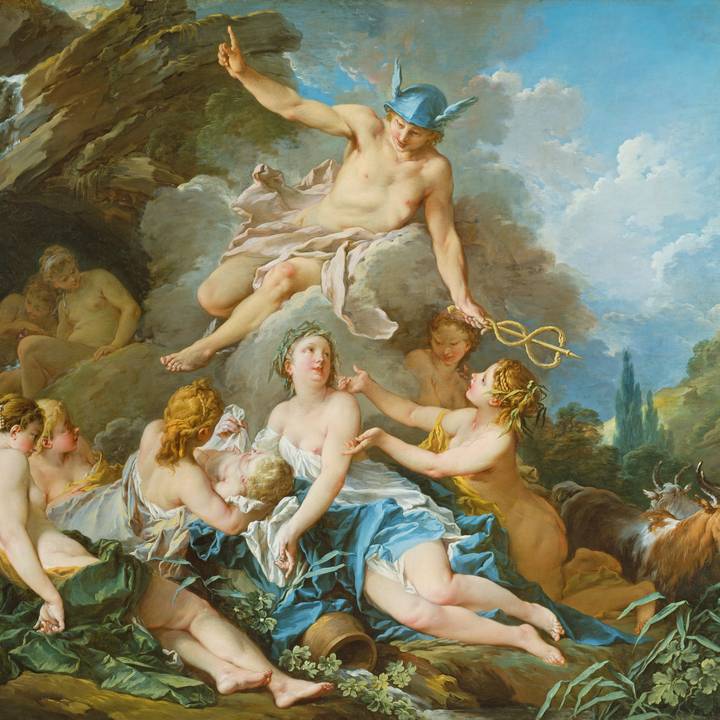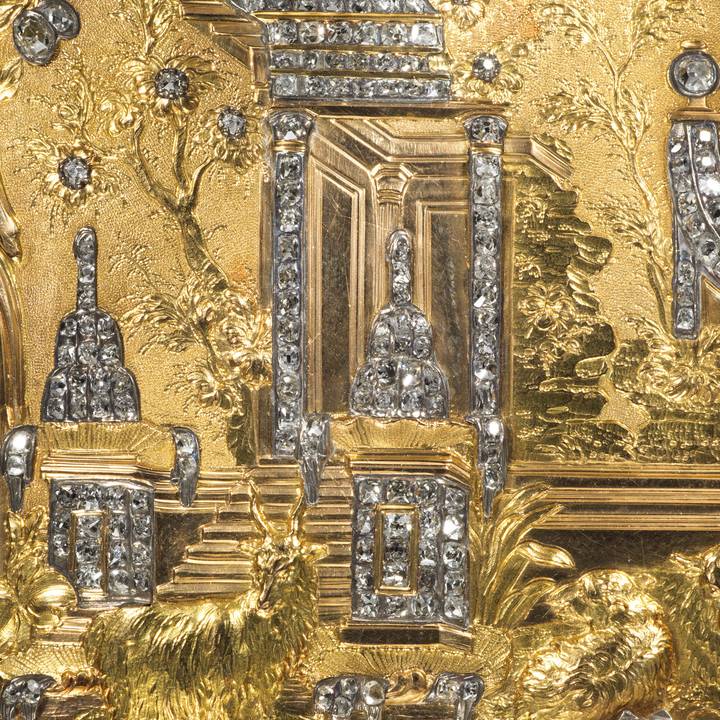
In 1750, Madame de Pompadour (1721-1764) embarked on a significant interior decoration project at the newly constructed Château of Bellevue, which the King had gifted her the previous year. Of all her residences, Bellevue was the only one she could oversee from start to finish and was, by all accounts, the most beautifully furnished.
With its stunning view over the Seine, proximity to the royal Château of Meudon, and relatively close distance to Versailles, Bellevue became one of Madame de Pompadour's cherished projects.
François Boucher (1703–1777) was hired to decorate some of the château's finest rooms, creating overdoors and tapestries for the King's apartments.
Formal bedrooms at the time often featured tapestries. At the end of the 1740s, Boucher created a new and grandiose series of tapestries for the Beauvais manufactory, The Love of the Gods, first woven in 1749. This tapestry contained scenes such as Apollo and Clytie, as Boucher reimagined well-known themes from Ovid that appealed to affluent private collectors.
Drawing from large-scale works by notable Baroque artists, Boucher incorporated visual references from their compositions while maintaining his distinct style.
His ability to craft opulent yet modern tapestries inspired Madame de Pompadour to commission a series for the King’s bedroom at Bellevue—tapestries intended to be both monumental and fresh, witty, and personal, much like Apollo and Clytie.
Boucher’s masterpieces, The Rising of the Sun and The Setting of the Sun, widely considered his finest works, were originally commissioned as tapestry designs in 1752. As an Academy member, Boucher was required to produce small originals by his own hand and large copies either painted by him or overseen to a high standard.
These large versions served as models for the weavers, while the smaller pieces were kept by the head weaver as a reference for the entire tapestry. These were the first major tapestries Boucher designed for the Royal Gobelins Manufactory which was more prestigious than the Beauvais manufactory.
The tapestries took over three years to weave and cost 8,160 livres, making them the most expensive works created at Gobelins. Their intricate compositions required a team of specialised weavers. The importance of this commission was highlighted by the unusual practice of withdrawing the cartoons partway through production to exhibit them at the 1753 Salon and Madame de Pompadour reclaimed the cartoons once the tapestries were completed in 1755.
Click and zoom below to explore the Rising of the Sun in detail
The cartoons later decorated the Swiss Guards' room on Bellevue’s ground floor, while the finished tapestries, The Rising of the Sun and The Setting of the Sun, adorned the King’s bedchamber, placed in frames on opposing walls where they were visible from the bed.
Positioned in this way, The Setting of the Sun captured the evening light from the west, while The Rising of the Sun was illuminated by morning light from the east. The Setting of the Sun was the first of the two to be painted. Boucher and Madame de Pompadour collaborated to create an iconography that referenced the era of Louis XIV, the Sun King.
Click and zoom below to explore the Setting of the Sun in detail
The storyline for The Rising of the Sun and The Setting of the Sun comes from Ovid’s Metamorphoses. In Ovid’s tale, Apollo rises daily in his chariot from the ocean, travels across the heavens to bring light to the world, and returns to the sea in the evening, where he is welcomed by Queen Tethys, wife of Oceanus.
At Louis XIV’s court, an amorous layer was added when Tethys merged with the sea nymph Thetis, Apollo’s lover. The grotto Grotte de Thétis near Versailles featured a sculpture of Apollo relaxing after his daily labors, symbolising Louis XIV’s respite after governing.
Madame de Pompadour, well-versed in this myth’s nuances, is represented in The Setting of the Sun through Thetis, who, with open arms, awaits Apollo/Louis, ready to relieve him of state duties at her Bellevue sanctuary. The Rising of the Sun references the grandeur of Versailles, with Madame de Pompadour’s theatrical counterparts, Aurore and Egine, depicted handing Apollo the reins of his chariot, suggesting her role in empowering the radiant god to begin his day. The significance of Madame de Pompadour’s commission inspired Boucher to develop a new style tailored to the grandeur of these subjects.
Responding to critiques of his previous ‘picturesque’ style, Boucher toned down the elaborate detail and vibrant colors typical of his earlier works, such as The Abduction of Europa or Mercury confiding the infant Bacchus. Instead, he focused on undraped nudes and cohesive compositions that conveyed a monumental elegance.
Boucher was also influenced by Roger de Piles' (1635-1709) aesthetic theories, which paralleled painting with music and poetry. De Piles’ Cours de peinture par principes was the first major aesthetic theory in post-Classical art to argue that art’s visual impact should be valued independently of literary or didactic content.
De Piles believed that if a work lacked visual appeal, its deeper meaning was secondary. He emphasised the importance of a work’s immediate impact, which should captivate viewers and transport them into art’s imaginative realm. This required a balanced harmony of light, shadow, and color to create a striking visual effect.
In both The Rising of the Sun and The Setting of the Sun, Boucher realised De Piles’ theories with dramatic movement drawing the viewer into the scenes. The darker tones at the canvases’ edges move toward a luminous center, where Apollo radiates light. Shadows are carefully controlled to maintain balance, and colors are harmonised to achieve a ‘silvered’ effect typical of Boucher’s later style, favoring delicate shades of pink, blue, green, and gray. Each painting has its own tonal quality: The Setting of the Sun is deliberately darker than The Rising.
The figures in The Rising of the Sun and The Setting of the Sun create a diverging sweep of movement. Apollo’s descent from his chariot toward Thetis’s outstretched arms adds a delicate grace to the protagonist’s gestures, telling their relationship through posture rather than facial expressions.
With flowing golden locks, Apollo turns from the naiad offering his lyre (symbolising his role as the god of arts) to gaze at the goddess of dawn who heralds his arrival in the sky. Boucher’s playful approach is evident as he transforms Homer’s “rosy-fingered dawn” into a maiden with literal roses for fingers.
In The Setting of the Sun, the winged figure of Sleep prepares to envelop his mother, Night, with a velvet curtain, a motif playfully echoed by cupids in The Rising of the Sun. Naiads, tritons, and cupids gracefully pose in both works, their relaxed, sensual forms enhancing the sense of repose as they look toward Apollo.
In both paintings, Boucher’s depiction of Apollo emphasises a tanned physique and masculinity contrasted with the pale, luminous forms of the naiads.
Apollo’s face and posture are elegant, with a youthful and aristocratic air that flatters Louis XV, the king’s symbolic double. Boucher’s female figures, meanwhile, have evolved toward a more classical ideal, with softer, rounder features and voluptuous bodies that convey an unashamed sensuality.
The Rising of the Sun and The Setting of the Sun remain stunning examples of Boucher’s mastery, embodying De Piles’ principles while interpreting Ovid’s poetry with originality, much like Titian and Rubens before him. Although less philosophically demanding, Boucher’s vision captivates the senses in a way that no artist had before.
Text adapted from Hedley, J., Francois Boucher: Seductive Visions, London, 2004.



